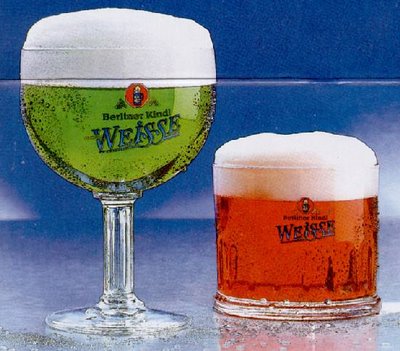This is the first of what I am sure will be many post about our berliner-weiss. Berliner-weiss is a sour wheat beer that some people add syrup to after it is poured into a glass. I am assuming that glass in the picture above, the green beer is apple syrup and the red is raspberry syrup. I have tried both along with vanilla, all are yummy.
Sour beers are becoming more popular in the US. I think part of this is because many of the microbreweries want a challenge, I will get in to this latter on. The other reason for the rise of the sour beers is that, they are apparently more appealing to women. I can kinda see where that is coming from. Too many american breweries are obsessed with hops. Even traditional styles that should have little to no hops, are crammed with hops. As a generalizations, most women don't like IPAs or other hoppy beers.
The reason why sours are fun is because they are a challenge. For sour beers, both yeast and a bacteria fermenting sugars to alcohol. The reason why sour beers have a higher alcohol content is because, bacteria can use sugars that yeast can not and bacteria can thrive in a high alcohol enviroment. The other issue is the same bacteria that you use for souring a beer is the same bacteria that can spoil your beer. That is why some breweries do not make sour beers or the bacteria fermentation takes place off site.
Usually for sour beers there are two separate fermentations, first yeast then bacteria. The yeast will have a long fermentation time of a month, and then bacteria will then ferment the beer for three months. For a berliner-weiss both fermentations take place at the same time, so the total fermentation time is two to three weeks, which is a lot better than four months.
The picture about is the starter for our bacteria, Lactobacillus acidophilus. The yeast can out compete the bacteria for sugars, it is because that there needs to be more bacteria than yeast at the beginning of the fermentation. We made a starter mixture of apple juice, honey and 'brewers nutrients'. L. acidophilus is the same bacteria found in yogurt. It's perfectly happy growing at high temperatures which is nice because it excludes other things from growing in the bottle. Placing the slow cooker on warm kept the culture at 100-120F. The bacteria culture grew for a week before we started brewing.
The bacteria bottle was cooled to 80F and then the yeast was added. After three hours the bacteria/yeast mixture was added to the fermenter. Three hours after that there was a ton of activity. I think the yeast fermentation should be done in a week and a half, which leave a few days for the bacteria to ferment on it's own. We will test the beer in two weeks.




I don't think I've ever tried a sour beer. Interesting, the differences in the preparation and fermentation.
ReplyDeleteThe first time I had a sour beer was at Russian River Brewing Company years and years ago. I saw they had it on the menu, and as I like sour things I was eager to try it. Suffice it to say it blew me away. I'll be talking a bit more about the history of the Berliner Weiss as well as the chemistry that causes a sour beer to be more alcoholic (though that doesn't mean high alcohol content necessarily).
DeleteWe've been working with porters but were recently chatting about the rise of the sour beer last weekend, it's a bit more than we are ready for but I look forward to hearing how yours comes out.
ReplyDeleteSo far so good, just be aware we've found that wheat beers tend to be a great deal more active during fermentation so expect some blowouts occasionally. I was originally thinking of priming with Speise (my preference for any traditional beer), but Kristi had suggested otherwise. Sadly we found it's the standard for Berliner Weiss too late, but I'm still on the lookout for a good traditional priming sugar to use that I feel won't detract from the flavor profile.
Delete